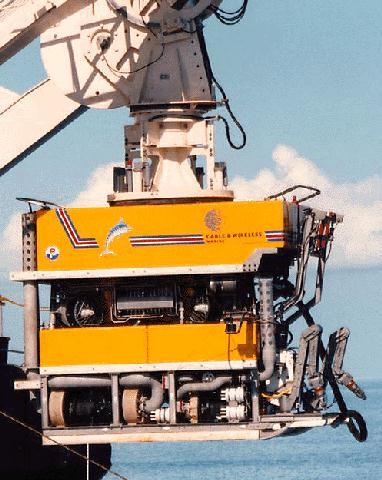
ROV
Brush Cleaning

ROV's and underwater cleaning has been a long developing process. The most obvious uses has been for an ROV to replace a Diver in the more simple cleaning applications such as Shiphull Cleaning, Harbour walls, Hydro Electric dams and waterways, Bridge foundations, Concrete and Steel structures Offshore.
General Introduction
The cleaning has developed from using Divers or modified Divers Brush cleaning equipment to highly specialised ROV cleaning equipment.
Unfortunately the general market for ROV cleaning tasks are quite patchy so the equipment tends to be hired in from ROV tooling and rental companies and the equipment is then fitted to the ROV. The disadvantages with this is that the ROV operating company does not really have any interest to develop the Brush cleaning equipment to perform at it's optimum performance with the ROV, and subsequently the Tooling rental company can not afford to make the tool 100 % ROV compatible since the next user could be a Diver.
The Brush cleaning equipment normally consists of a motor gearbox arrangement were a Brush of some description is fitted.
The power to the motor unit is normally by Water or Hydraulic means.
In the ROV application a special ROV attachment is fitted with a vibration dampening device to insulate the tool vibrations from the ROV as much as is possible.
Brush Cleaning can be performed using a Single Wire Brush unit on a Hydraulic Motor and Dual headed cleaning units.
There are some units with up to six brush motors attached.
ROV's can operate several different Hull cleaning Brush systems both Water powered and Hydraulic powered. The cleaning speed is approximately 200 to 500 square metres an hour. The advantages of ROV's cleaning a ships hull is that the ROV can be deployed at almost any remote location from a small vessel or mobilised onboard the vessel to be cleaned. and work for 24 hours a day without stopping.
One important factor in considering ROV's for cleaning a Vessel hull is that the seawater visibility should be fair to good since without visibility or poor visibility the ROV Brush cleaning rate will be very slow due to the ROV's inability to Navigate well underwater with poor visibility.
Most Brush cleaning packages for ROV's are Diver units that has been modified.
The ROV can at the same time have a Video taken for inspection purposes and perform a range of different Non Destructive Testing tasks.
The ROV can clean in most harbour or seawall locations if only the current is not to strong or the Visibility is to poor. The general limits for an ROV operating in these conditions are as follows.
Current: 1 Knot
Visibility: 2 metres minimum
There are ROV systems that can operate outside of these limits but these ROV's are one off or very special and hard to come by.
The ROV is also the Ideal tool for making a Video or perform other Non destructive testing on the Harbour structures.
Hydro electric dams and waterways
Smaller ROV's can perform several tasks in and around a Hydro Electric installation from Inspecting water intakes surge shafts and tunnel doors.
The cleaning would be performed using specially adopted brushes for concrete surfaces or steel doors.
The ROV can also repair conrete walls by applying concrete to cracks and other defects, sometimes special underwater epoxy resins have been used.
The Cleaning around Bridge foundations can be performed very easily, the cleaning will quickly show defects in the concrete and scouring on the seabed. A special Concrete cleaning package is available to fit to most work ROV's.
Inspection can be performed with the onboard Colour Video Camera and most types of Still Camera Formats can be accomodated.
Cleaning steel or concrete oil platforms or other structures is very easy for an ROV to perform. Platform cleaning has been performed by several ROV companies since the mid eighties. was performed on all kinds of Platform Node configurations from complicated K-nodes to straight leg sections. the average cleaning speeds were around 4 meters of weld bead per hour. this was measured as a clean area with a 100 mm wide clean section on either side of the weld being cleaned.